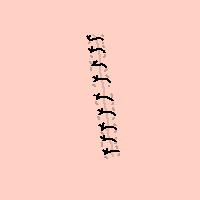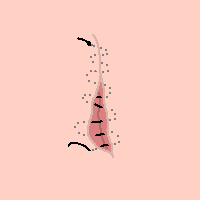Surgery
This page discusses some basic aspects of surgery.

Suturing
Suturing is the process of stitching tissues of the body together to maintain position and
promote unionised healing. This usually requires a needle (typically curved) and thread. Although
commonly used to repair wounds, they can be used to alter tissues in the body even when no wound
was initially present such as to repair a congenital abnormality or create an anastomosis of the
intestine, or to secure new material such as heart valves or mesh implants.
Part of a surgeon's job is to choose appropriate suturing materials and techniques depending on the specific
task and patient they are presented with. A 'bite' refers to tissue being tissue being penetrated and
therefore encompassed by a single pass of the suture needle during the stitch. Each bite must be controlled,
as adequate thickness and depth is required to achieve proper wound closure.
Suturing - Common Patterns
Interrupted Sutures
In interrupted sutures, each stitch is individually tied. This creates a series of separate
knots along the wound. This allows for precision in wound edge approximation, and allows for customization
of tension per stitch. However, it can be more time-consuming to a continuous technique, and may also
result in greater use of suture materials.

Continuous Sutures
Continuous sutures use a single strand of suture material to create a line of stitches along a wound.
They are generally faster to place than interrupted sutures and ensure a roughly even distribution of tension
along the wound. However, if one part of the suture fails, the entire line could be compromised.

Mattress Sutures
Mattress sutures take bites of tisssue both deep and superficial to the wound. They can be stitched
horizontally or vertically relative to the wound. These provide better tissue eversion (turning the edges outward)
than simple interrupted sutures, and offer increased strength/support. However, the increased compression may
reduce the blood supply causing tissue ischaemia.

Subcuticular Sutures
For subcuticular sutures, they are placed underneath the surface of the skin, reducing visibility.
This enhances their cosmetic outcome, as it also does not leave suture marks on skin, and reduces the risk
of wound infection. However, subcuticular sutures don't provide the same strength as some other suture patterns,
and are limited to use on superficial wounds.

Suturing - Common Materials
Needles
Needles are defined by their size, shape and tip. Most needles are curved, as these are easy to use
in small spaces and can penetrate tissues with convenience via rotating the tip into the tissue. Straight needles
can be used for shallow wounds to achieve precision and good cosmetic outcomes, but they require more space to
manouevre so can't be used in deep tissues, such as inside the body in a surgery.
Not all needles need to be equally sharp. Blunt ends are less likely to injure the user or the patient,
although they require more force per bite. The abdominal wall is usually sutured with a blunt needle, as there is
a risk of serious consequences if there is an accidental perforation of the bowel.
Threads
Sutures can be made with absorbable or non-absorbable materials. Absorbable materials will break down
within a couple of months of application, once initial healing is complete. 'Non-absorbable' in the context of sutures
generally refers to those that won't break down within the several weeks since application. Not all will remain in the
body permanently, but some can if they aren't removed. Long-term sutures can be helpful for tissues that will not heal
to take the tensile strength on their own, or to hold synthetic materials in place. Non-absorbable materials can also
be preferred for application and removal for wounds on skin as absorbable materials, often made with organic proteins,
can react with local tissues.
Suture threads can be made up of one or more strands/filaments. Monofilament strands are low friction, and
are waterproof. They result in minimal tissue trauma, reactivity and infection, and offer some more elasticity compared
with multifilamnet sutures. They can, however, cause pain and damage weaker tissues, due to their relatively firm and sharp
edges. Multifilament sutures can increase the risk of infection and reactivity, but they are more pliable, stronger, and
more secure.






